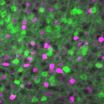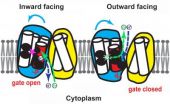Biologists find 'missing link' in the production of protein factories in cells
2014-06-23
(Press-News.org) Biologists at UC San Diego have found the "missing link" in the chemical system that enables animal cells to produce ribosomes—the thousands of protein "factories" contained within each cell that manufacture all of the proteins needed to build tissue and sustain life.
Their discovery, detailed in the June 23 issue of the journal Genes & Development, will not only force a revision of basic textbooks on molecular biology, but also provide scientists with a better understanding of how to limit uncontrolled cell growth, such as cancer, that might be regulated by controlling the output of ribosomes.
Ribosomes are responsible for the production of the wide variety of proteins that include enzymes; structural molecules, such as hair, skin and bones; hormones like insulin; and components of our immune system such as antibodies. Regarded as life's most important molecular machine, ribosomes have been intensively studied by scientists (the 2009 Nobel Prize in Chemistry, for example, was awarded for studies of its structure and function). But until now researchers had not uncovered all of the details of how the proteins that are used to construct ribosomes are themselves produced.
In multicellular animals such as humans, ribosomes are made up of about 80 different proteins (humans have 79 while some other animals have a slightly different number) as well as four different kinds of RNA molecules. In 1969, scientists discovered that the synthesis of the ribosomal RNAs is carried out by specialized systems using two key enzymes: RNA polymerase I and RNA polymerase III. But until now, scientists were unsure if a complementary system was also responsible for the production of the 80 proteins that make up the ribosome.
That's essentially what the UC San Diego researchers headed by Jim Kadonaga, a professor of biology, set out to examine. What they found was the missing link—the specialized system that allows ribosomal proteins themselves to be synthesized by the cell.
"We found that ribosomal proteins are synthesized via a novel regulatory system with the enzyme RNA polymerase II and a factor termed TRF2," Kadonaga says. "For the production of most proteins, RNA polymerase II functions with a factor termed TBP, but for the synthesis of ribosomal proteins, it uses TRF2."
"The discovery of this specialized TRF2-based system for ribosome biogenesis," he adds, "provides a new avenue for the study of ribosomes and its control of cell growth, and should lead to a better understanding and potential treatment of diseases such as cancer."
INFORMATION:
Other authors of the paper were UC San Diego biologists Yuan-Liang Wang, Sascha Duttke and George Kassavetis, and Kai Chen, Jeff Johnston, and Julia Zeitlinger of the Stowers Institute for Medical Research in Kansas City, Missouri. Their research was supported by two grants from the National Institutes of Health (1DP2OD004561-01 and R01 GM041249).
ELSE PRESS RELEASES FROM THIS DATE:
The brain's balancing act
2014-06-22
Researchers at the University of California, San Diego School of Medicine have discovered a fundamental mechanism by which the brain maintains its internal balance. The mechanism, described in the June 22 advanced online publication of the journal Nature, involves the brain's most basic inner wiring and the processes that control whether a neuron relays information to other neurons or suppresses the transmission of information.
Specifically, the scientists have shown that there is a constant ratio between the total amount of pro-firing stimulation that a neuron receives ...
Mysterious 'Magic Island' appears on Saturn moon
2014-06-22
ITHACA, N.Y. – Now you don't see it. Now, you do.
And now you don't see it again. Astronomers have discovered a bright, mysterious geologic object – where one never existed – on Cassini mission radar images of Ligeia Mare, the second-largest sea on Saturn's moon Titan. Scientifically speaking, this spot is considered a "transient feature," but the astronomers have playfully dubbed it "Magic Island."
Reporting in the journal Nature Geoscience June 22, the scientists say this may be the first observation of dynamic, geological processes in Titan's northern hemisphere. ...
Regional weather extremes linked to atmospheric variations
2014-06-22
Variations in high-altitude wind patterns expose particular parts of Europe, Asia and the US to different extreme weather conditions, a new study has shown.
Changes to air flow patterns around the Northern Hemisphere are a major influence on prolonged bouts of unseasonal weather – whether it be hot, cold, wet or dry.
The high altitude winds normally blow from west to east around the planet, but do not follow a straight path. The flow meanders to the north and south, in a wave-like path.
These wave patterns are responsible for sucking either warm air from the tropics, ...
Architecture of signaling proteins enhances knowledge of key receptors
2014-06-22
DURHAM, N.C. -- A team of scientists from Duke Medicine, the University of Michigan and Stanford University has determined the underlying architecture of a cellular signaling complex involved in the body's response to stimuli such as light and pain.
This complex, consisting of a human cell surface receptor and its regulatory protein, reveals a two-step mechanism that has been hypothesized previously but not directly documented.
The findings, reported on June 22, 2014, in the journal Nature, provide structural images of a G-protein coupled receptor (GPCR) in action.
"It ...
Study shows greater potential for solar power
2014-06-22
Concentrating solar power (CSP) could supply a large fraction of the power supply in a decarbonized energy system, shows a new study of the technology and its potential practical application.
Concentrating solar power (CSP) could supply a substantial amount of current energy demand, according to the study published in the journal Nature Climate Change. In the Mediterranean region, for example, the study shows that a connected CSP system could provide 70-80% of current electricity demand, at no extra cost compared to gas-fired power plants. That percentage is similar to ...
Microenvironment of hematopoietic stem cells can be a target for myeloproliferative disorders
2014-06-22
The discovery of a new therapeutic target for certain kinds of myeloproliferative disease is, without doubt, good news. This is precisely the discovery made by the Stem Cell Physiopathology group at the CNIC (the Spanish National Cardiovascular Research Center), led by Dr. Simón Méndez–Ferrer. The team has shown that the microenvironment that controls hematopoietic stem cells can be targeted for the treatment of a set of disorders called myeloproliferative neoplasias, the most prominent of which are chronic myelomonocytic leukemia (CMML), juvenile myelomonocytic leukemia ...
Family of proteins plays key role in cellular pump dynamics
2014-06-22
Case Western Reserve University scientists have discovered how a family of proteins — cation diffusion facilitators (CDFs) — regulates an important cellular cycle where a cell's energy generated is converted to necessary cellular functions. The finding has the potential to inform future research aimed at identifying ways to ensure the process works as designed and, if successful, could lead to significant breakthroughs in the treatment of Parkinson's, chronic liver disease and heart disease.
The results of this research were posted online June 22 by the journal Nature ...
Evidence found for the Higgs boson direct decay into fermions
2014-06-22
For the first time, scientists from the CMS experiment on the Large Hadron Collider (LHC) at CERN have succeeded in finding evidence for the direct decay of the Higgs boson into fermions. Previously, the Higgs particle could only be detected through its decay into bosons. "This is a major step forwards," explains Professor Vincenzo Chiochia from the University of Zurich's Physics Institute, whose group was involved in analyzing the data. "We now know that the Higgs particle can decay into both bosons and fermions, which means we can exclude certain theories predicting that ...
Protons power protein portal to push zinc out of cells
2014-06-22
Researchers at The Johns Hopkins University report they have deciphered the inner workings of a protein called YiiP that prevents the lethal buildup of zinc inside bacteria. They say understanding YiiP's movements will help in the design of drugs aimed at modifying the behavior of ZnT proteins, eight human proteins that are similar to YiiP, which play important roles in hormone secretion and in signaling between neurons.
Certain mutations in one of them, ZnT8, have been associated with an increased susceptibility to type 2 diabetes, but mutations that destroy its function ...
Molecular footballs could revolutionize your next World Cup experience!
2014-06-22
This work focuses on the interactions between molecules and in particular on "amphiphilic" molecules, which contain two distinct parts to them. Household detergent is a good example of a product that relies on interacting amphiphilic molecules. Detergent molecules comprise two distinct parts: one that prefers to form bonds with water (hydrophilic) and the other that likes oily substances (hydrophobic). Detergents are used for cleaning because when they are added to dirty water, they orient and assemble around oily dirt, forming small clusters that allow grease and dirt ...



